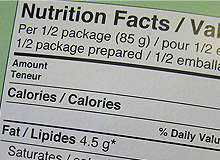
Obesity is on the rise in Europe. According to the World Health Organisation, many European countries have seen obesity rates triple since the 1980s, with spiking levels of childhood obesity being particularly worrying. In some European states, more than 10% of deaths can be at least partly attributed to obesity.
As has been unequivocally stated on many occasions by a wide range of organisations and governments, this thoroughly modern problem has to be tackled by a multi-pronged campaign to encourage healthy eating and daily exercise while warning the public about the dangers of consistently overeating.
But what role can the food packaging industry play in slowing this rising trend? After all, packaging is the average consumer’s first point of reference when looking for nutritional information on a pre-packaged food product. This is the debate that has been flowing back and forth in the European Parliament for much of the last year.
The EU labelling debate
On 7 December last year, after months of work by the EU Council Working Groups, MEPs agreed on a new set of food labelling requirements at the Health Council. The most fundamental proposal is a new mandatory requirement to set out clear, legible nutritional information on most pre-packaged foods.
See Also:
While many details (such as minimum font sizes for the information, although a 3mm minimum has been proposed) are still to be finalised in later readings of the legislation due in the European Parliament later in the year, some facts are clear. Mandatory information on the amount of certain nutrients is being demanded on most products, with energy, fat, saturated fat, salt and sugars being specifically mentioned. These must be expressed as a percentage of an adult’s guideline daily amount (GDA), based on a 100mg or 100ml portion.
How well do you really know your competitors?
Access the most comprehensive Company Profiles on the market, powered by GlobalData. Save hours of research. Gain competitive edge.

Thank you!
Your download email will arrive shortly
Not ready to buy yet? Download a free sample
We are confident about the unique quality of our Company Profiles. However, we want you to make the most beneficial decision for your business, so we offer a free sample that you can download by submitting the below form
By GlobalDataAs well as nutritional information, the EU debated for the first time on including country-of-origin on food labels. It was decided that origin information would be made mandatory for fresh meat products, as well as in cases where not to include the information would actively mislead consumers. Checks on the authenticity of origin claims will also be bolstered, including providing further information on the place of origin.
Traffic light labelling system derailed
One of the most contentious outcomes of the new EU proposals is the rejection of the “traffic light” nutrition labelling scheme, which marks nutritional values in green, amber or red depending on their relative healthiness, in favour of simply stating percentages of GDAs. For the European food industry, this is a welcome move, as many companies have stated that the traffic light system unfairly demonises fatty products that can be eaten as part of a healthy diet. Paul Kelly, director of Irish food industry trade association Food and Drink Industry Ireland, was particularly strong in stating his organisation’s support for GDAs over any other nutrition information scheme.
“GDAs give consumers simple nutrition information on key nutrients such as saturated fat, sugars and salt, based on the portion size of the food being eaten,” he said. “They have been put on packs on a voluntary basis by industry since 2006, but it is important that they now become part of the legislation…The traffic light system of labelling is a subjective assessment of the nutrient content of 100g of a food and does not provide consumers with the information needed to choose a balanced diet based on their individual needs. In addition, ‘traffic lights’ fail to take account of portion sizes, and do not put the food in the context of the daily diet.”
Other groups see the move as a victory of industry lobbying over the interests of consumers. Corporate Europe Observatory (CEO), a corporate lobbying watchdog, reported that the Confederation of Food and Drink Industries of the EU (CIAA) had spent more than €1bn to lobby against the traffic light system, including TV adverts, lunch meetings and voting recommendation letters to MEPs.
In an article on its website, CEO stated its (and others’) preference for the stricter traffic light system. “Health and consumer campaigners argue that such labels are less effective because they rely on an arbitrary notion of a portion, and only reflect adult needs, which are not relevant for children – often the target market for snacks and sweets. They favour the traffic-light label which is much easier to understand for a larger audience and the most socially disadvantaged.”
Even with the less intrusive GDA approach, some companies have expressed their discomfort. UK newspaper the Daily Telegraph has reported that Ferrero, the Italian producer of Nutella hazelnut chocolate spread, claims that the new labelling requirements could frighten off potential customers. Even Italy’s Agriculture and Food Minister Giancarlo Galan has criticised the tougher approach, saying: “Sometimes, the strict application of rules…reveals their stupidity.” It seems that as these proposals move forward towards becoming full legislation, they may have found a staunch opponent in Italy.
The long road to legislation
The fact that EU parties have agreed on a framework for legislation does not mean that it will instantly become law; far from it, in fact. According to an interested parties letter from the UK Department for Environment, Food and Rural Affairs (Defra) dated 7 January 2011, the proposals will be subjected to another round of debate during their second reading in the spring of this year.
“The Regulation is expected to be finalised and published in early 2012. There will be appropriate transition periods for all businesses with the Council proposing three years for the labelling provisions although the mandatory requirement for nutrition labelling will not apply for five years,” according to Defra’s letter.
This means that although these issues are being brought to the table now, companies could have up until 2017 before the legislation comes into force. It also leaves plenty of time for hurdles to be thrown in the path of the legislation by industry bodies or opposing national governments.
These new regulations, if pushed through intact over the next two years, will present new challenges for the food and packaging industries to come up with creative ways to inform consumers while keeping their products looking fresh and appealing on store shelves. But any healthy industry should rise to new challenges, and the changes proposed by the EU could have a significant impact on the ever-growing problem of mass obesity across the continent.






